Graphics Design
10 Stunning Gradient Design Trends You Need to Know in 2024

10 Stunning Gradient Design Trends You Need to Know in 2024
As we stand on the brink of 2024, gradient designs are all the rave in the creative space and breathe life, color depth and contemporary into websites, branding and more. complicated gradients, which several years ago could impress only with conformity to the maximum bid, are the most promising direction to for all designers today, who want to innovate and create something interesting. If you are a designer or an owner of a business, or simply interested in design, these categories will give you an idea of what is new and developing in the field.
In this article, we’ll take a closer look at 10 **most important gradient design trends** that you should expect in 2024 with examples of their application and ideas about how they change the design industry.
Outline of the Article:
- Introduction
- 1. Retro Gradients
- 2. Neon Glow Gradients
- 3. Monochromatic Gradients
- 4. Pastel Gradients
- 5. Nature-Inspired Gradients
- 6. Duotone Gradients
- 7. 3D Gradients
- 8. Metallic Gradients
- 9. Transparent Gradients
- 10. Gradient Meshes
- Gradients today Modern Design
- Gradients in Design: Best Tips
- Conclusion
- FAQs
Introduction
Transitions have been a cornerstone of gradient design trends for a long time and being able to smoothly transition from one color hue to another to making designs come to life. As technology advances, and preferences change, the use of two material types is pioneering the look in 2024. As observed in web design and product packaging or digital marketing, the following 10 gradient design trends should help inspire the next big project.
1. Retro Gradients
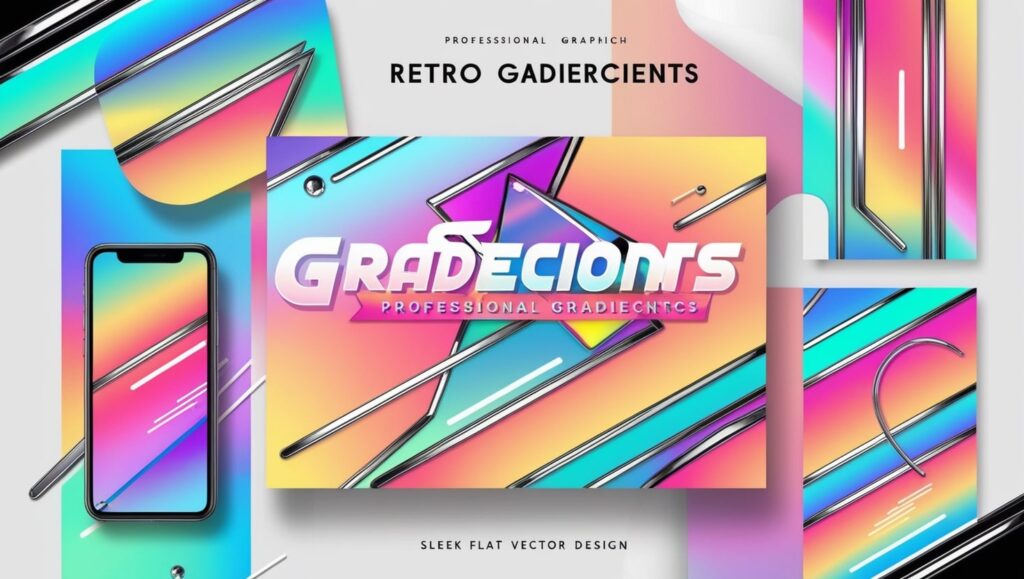
Gradient design trends the talk of the town ‘ nostalgia ‘ has called it’s shots on contemporary gradient design trends and brands and the retro gradients are back in business with full flavor in 2024. Intense colors associated with the pop-culture of the 80s and 90s are now features of designers’ works. Imagine an alternative world of neon pinks, electric blues and strong oranges combined in spectacular ways. These gradients are not just simply about the awesome colors, but are also about the mood of those decades, bringing an antique but fresh feeling to your designs.
Retro gradient design trends are used most often in the branding process and digital arts as they add dynamic energy to the artwork. Applying retro gradients in the creations aimed at youth or focused on a specific narrowly interested circle, it will be possible to succeed.
2. Neon Glow Gradients
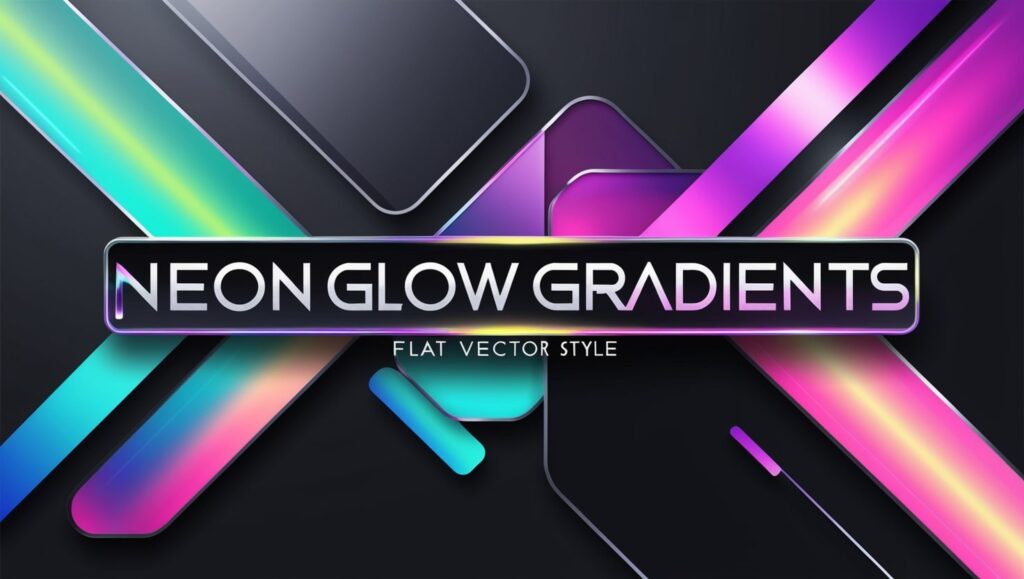
Other gradient design trends that light up like neon are also something to look forward to in 2024. These gradients combine and explode a number of colors such as fluorescent green, purple and pink. Smart gradients with the neon glow are perfect for nightlife, entertainments and fashion-related niches that require statement and futuristic vibes.
It is just adding these gradient design trends to branding or your digital interfaces can make them look sleek and modern, making your design stand out among the rest. Just then ensure that the colors are not very intense such that they overload your audience with color.
3. Monochromatic Gradients
Monochromatic gradient design trends, as the name suggests, is about the use of different instalments of the same color to ensure effects of continuity. This approach is quite elegant and simple, which will make it perfect for use in minimalistic design. It may sound a bit mundane but monochromatic gradients offer a certain degree of depth to the designs you make without necessarily straining the receiver’s eye.
In web and app design monochromatic gradients are widely used for backgrounds, buttons and any sort of navigation. They also play a part in making the site’s appearance more professional and cleanup, all the while still being engaging to the user.
4. Pastel Gradients
Gradient design trends views and opinions Pastel gradation is characterized by subtle changes in soft pastel colors that do not shock the eye. These gradients are particularly suitable in the wellness, style of life and beauty industries where comfort is of paramount importance. Try imagine weak shades of lavender that gradually turn into pastel blue or pale pink that gently transition into delicate cream color.
However, pastel gradient design trends are not only beautiful but also very suitable for a variety of design uses, as has been previously demonstrated. It makes them feel warm and comfortable and, therefore, if you want to get your audience in a good mood, these kinds of images will do just fine.
5. Nature-Inspired Gradients
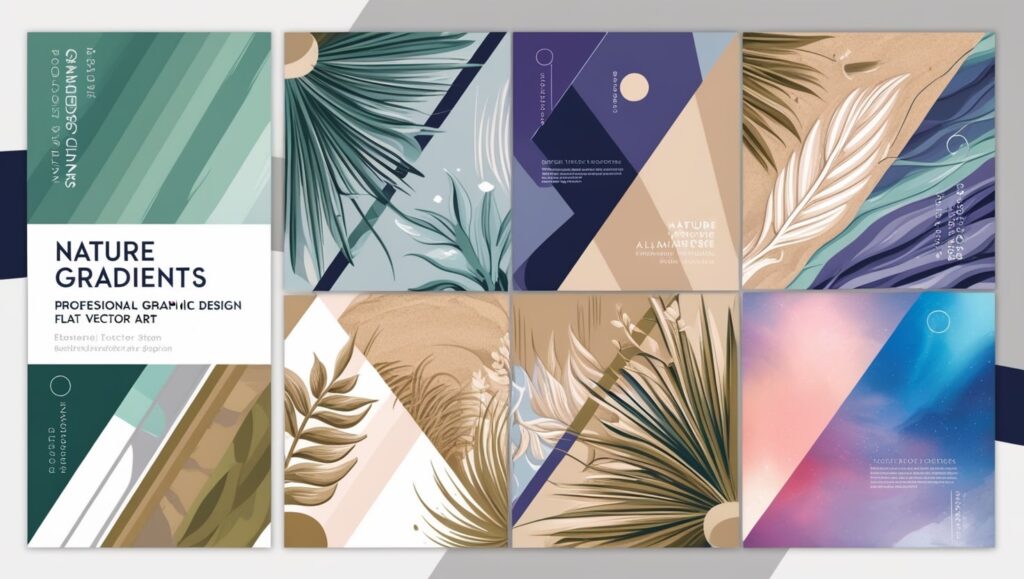
Having witnessed a steady adoption of sustainable and environmentally friendly approaches to life, natural gradients are making a comeback. These gradients are based on natural color and they utilize earthy colours like forest green, sky blue and sunset orange.
The gradient design trends which are depicted using the logo of the natural world are ideal for the brands that have values attached to mother nature or those brands which would like to give their customers a feeling of calmness and serenity. These gradients are also part of biophilic design, which uses nature as a big part of the built environment to bring well-being.
6. Duotone Gradients
Duotone gradient design trends are made by using two different shades of color and the impression usually can be really strong. It is suitable when brands have to leave a strong image of themselves that would be easily memorable. It is also popularly integrated in the digital designs, advertisements, promotions, and any social media posts due to its ability to have an impact and flexibility in the redesign of the design.
For Instance, a duotone gradient shall combine an indigo hue with a lime green hue to come up with a modern look. This trend also seems perfect for typographic treatments, where text on top of duotone backgrounds, as you may imagine, only gets even more striking.
7. 3D Gradients

Currently, the application of 3D gradient design trends is on the rise as designers seek to create an illusion of depth when designing their images. It is possible to make a design look more realistic, allowing designers to enhance lighter and shadow items, as well as texture items and 3D shapes and objects, by applying gradients to them.
This trend is very pertinent to the field of UI/UX design since 3D gradients could make the users have a lot of fun. Wherever it pop up as a floating button or an animated object, 3D gradients make it look authentic and dynamic to look at.
8. Metallic Gradients
Every now and then, metallic gradient design trends are associated with luxury and sophistication. Coming up with hybrids of golds, silvers, bronzes and coppers festivals the designers with rich and chic appearance that portrays luxury. These gradients are ideal to be applied to premium brands and businesses that would like to make their brand(images) look more elegant.
Erect metallic gradients in your packaging, logos and websites that will be related to luxury goods. They also shine and create the illusion of sophistication that is immediately obvious but requires little effort to embody making it ideal for any design since it will make the design look more expensive and appealing.
9. Transparent Gradients
As simple as the gradients are, they are perfect for the addition of depth without necessarily being too distracting. Hence, if incorporation of transparency was made, designers can infuse colors at different levels producing complex kind of impression. This trend is especially used often in website layout designs, where you can use the smooth gradient to create background, overlay and the hover effects.
By combining different levels of color transparency you’ll achieve a highly appealing color hierarchy which along with minimalist progressing will illuminate important sections.
10. Gradient Meshes
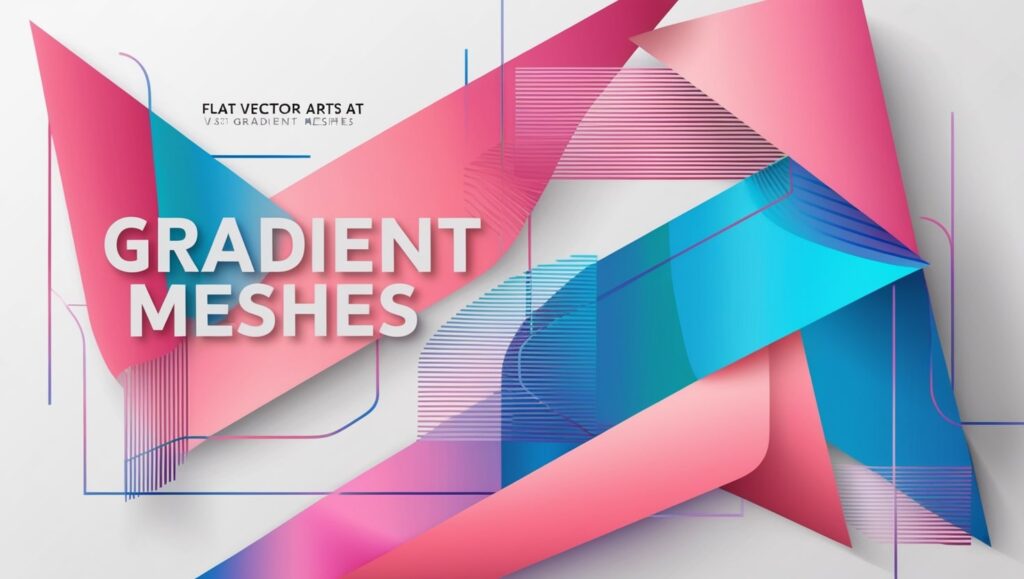
They are a technique feature a little more complex than standard pixel blending, and is commonly referred to as gradient meshes. While the linear or radial gradients are a form of approach allowing designers to create smooth transition between two colors at certain point of an object or background, gradient meshes propel designers to creating complex gradients between multiple colors at different points. This technique is prevalent in vector graphic design since the operation involves precision and the smooth workflow.
Gradient design trends meshes are subsequently tender and primarily used in illustrations and digital art where shading, which is realistic, and blending of colors, which may be fancy or complex, are paramount. They let one achieve highly personalized layouts that appear to serve specific needs of a given project or process.
Gradients today Modern Design
Gradient design trends can add an exciting and sophisticated look to any design which put them in a rather strong position in a designer’s portfolio. They can give extra dimensions, target attention and produce a more stimulating point of view. In general, gradients are now widely used for something that has gained importance with the appearance of digital interfaces: the need to make flat designs monumental. This makes them adaptable in almost any field ranging from the new technological venture to refined brands of production.
Gradients in Design: Best Tips
However, gradients are definitely useful, although their application should be used correctly. Here are a few tips:
- **Balance**: Avoid the problem of the gradients overwhelming other design elements.
- **Context**: We must remember the target audience and the field of the project while selecting colors.
- **Consistency**: Be consistent in your choice of colors to ensure that you do not end up with contrasting visuals on your design that may not blend well.
- **Accessibility**: Make sure that every gradient is responsive and can be read by different people on various devices.
Conclusion
Gradient design trends as we anticipate the year 2024 remains dynamic thereby enhancing the creativity by tendering unending options. These are the trends that are already shaping the future of the visual design, from the old school with retro themes and neon flashes to such outstanding pieces like glowing nature and three-dimensional simulations. From web design to branding projects or illustration, these gradient trends will see you through to the next level and onwards.
FAQs
- Even though identifying this feel is not straightforward, the next questions pops up: what is the key to choosing the right gradient?
Connect with the core focus of the video plus the emotions desired from the audience to be effective. When implemented they should complement your design.
and can correspond to the registration of the brand image in consumers’ perceptions.
- In other words, are gradients appropriate for any kind of design work?
Yes indeed, gradients are very flexible and can be used anywhere from website UI to product labeling. Yet, the application of all of them should be adjusted according to the particular project requirements.
- What can I do to make my gradient design look good on devices?
Consistency of gradients must be checked across the screens and different resolutions – this must be achieved by using responsive design techniques and testing gradients on the interval of that.
- I am trying to design an interface and the problem that I faced is that bright gradients may overload users.
Balance is key. Applying gradients in bright tones is better when applied minimally or accentually with background with less distracting neutral colors.
- As much as I appreciate gradients, I have no idea of the kind of tools I can use to make mine look excellent.
Some of the most well-known tools include Adobe Illustrator, Figma, Sketch, and simple web-based tools to get gradient ideas and to make gradients, Gradient Hunt and Coolors.
Graphics Design
Top 10 Best Graphic Design Tools for Beginners in 2025 (Free & Paid)
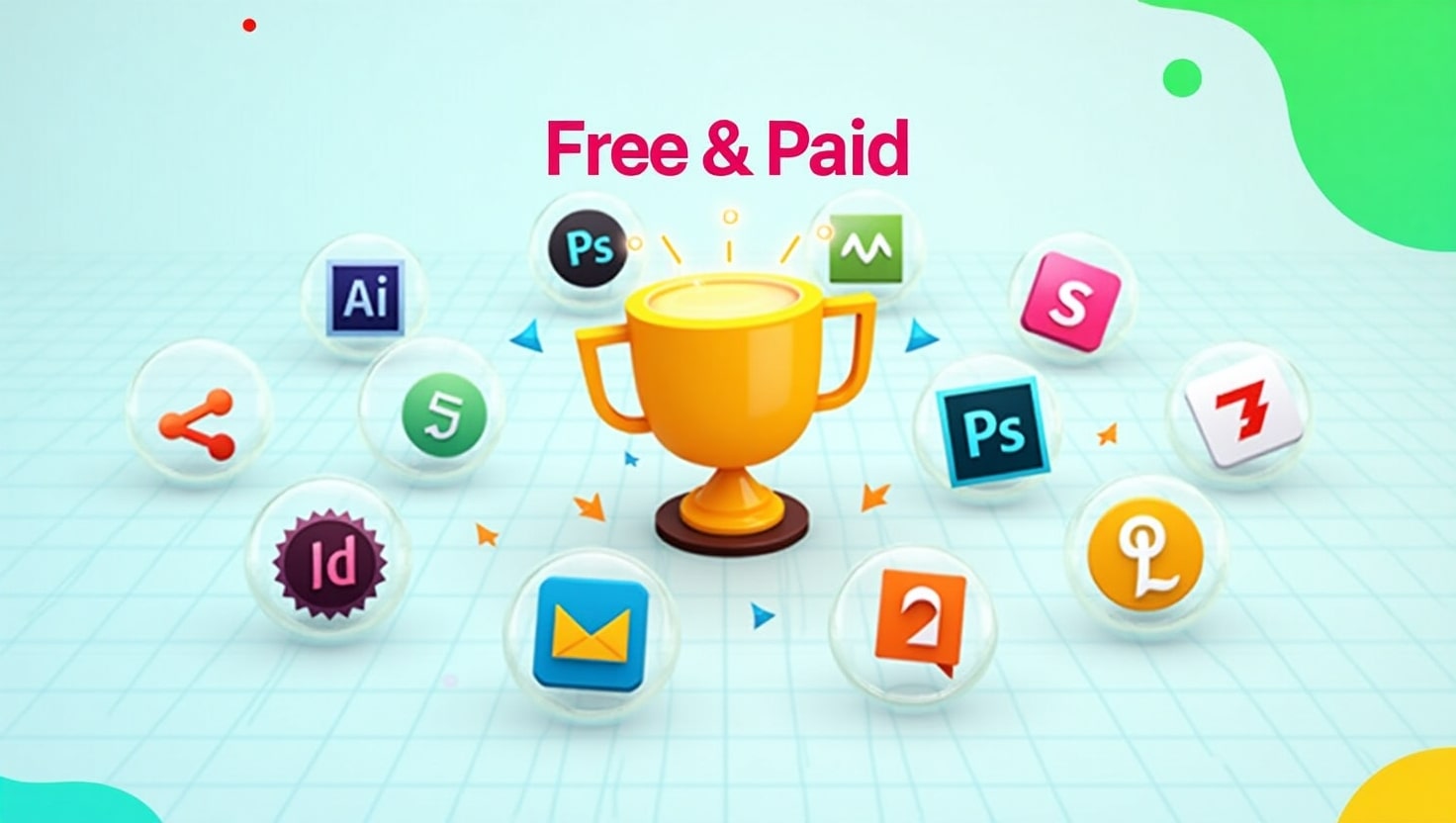
Top 10 Best Graphic Design Tools for Beginners in 2025 (Free & Paid)
Introduction: Why Beginners Need the Right Tools
Best graphic design tools for beginners can be exciting but also overwhelming. With so many tools available, it’s easy to get lost in the options. As a beginner, you need graphic design tools that are easy to learn, affordable, and feature-rich enough to help you grow. Whether you’re designing logos, social media posts, or website graphics, the right software can make all the difference.
In this article, we’ve handpicked the top 10 best graphic design tools for beginners in 2025, including both free and paid options. Whether you’re looking to go pro or just explore your creativity, there’s a tool here for you.
1. Canva – Best for Simplicity
Type: Free & Paid
Platform: Web, iOS, Android
Canva is best graphic design tools for beginners who want to dive into design without the steep learning curve. With drag-and-drop features, pre-made templates, and an intuitive interface, Canva allows anyone to create professional-looking graphics in minutes.
Key Features:
- Thousands of free templates
- Easy-to-use interface
- Perfect for social media posts, presentations, and posters
- Team collaboration options
Why it’s great for beginners: You don’t need design experience to use Canva. It’s as simple as choosing a template and customizing it.
2. Adobe Illustrator – Industry Standard
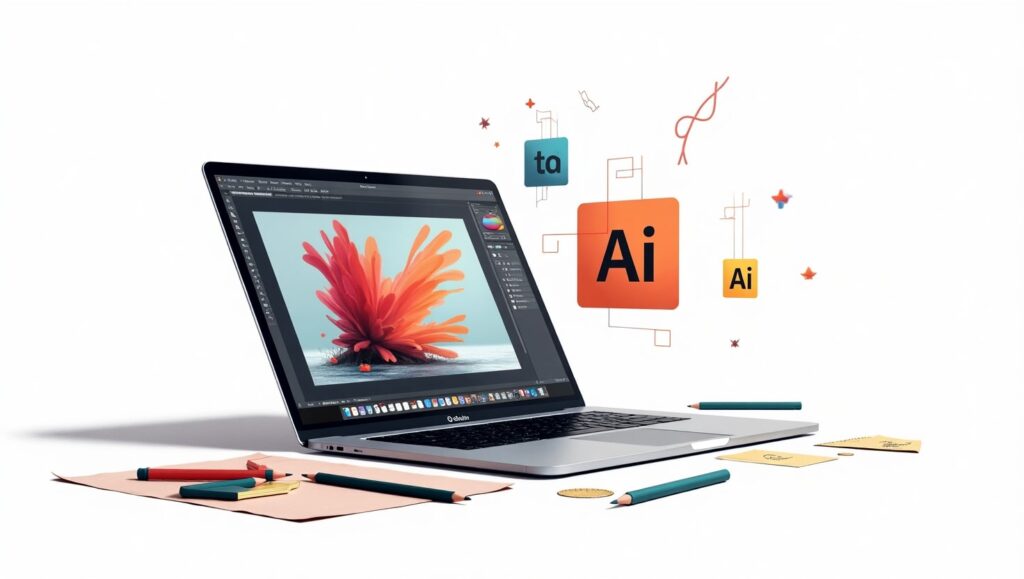
Type: Paid (Free trial available)
Platform: Windows, macOS
If you’re serious about pursuing best graphic design tools for beginners professionally, Adobe Illustrator is the go-to tool. It’s used by top designers around the world for creating logos, icons, typography, and complex illustrations.
Key Features:
- Precision vector design
- Integration with other Adobe apps
- Extensive typography tools
- Custom brushes and effects
Why it’s great for beginners: Though it has a steeper learning curve, beginners can start with tutorials and gradually master this powerful tool.
3. Figma – Collaborative Design

Type: Free & Paid
Platform: Web-based (with desktop apps)
Figma is a browser-based UI and best graphic design tools for beginners that’s widely used for interface design and collaboration. It’s especially ideal if you’re working in a team or planning to get into UX/UI design.
Key Features:
- Real-time collaboration
- Cloud-based autosave
- Works on any platform
- Design + prototyping in one tool
Why it’s great for beginners: It’s free to get started and encourages team-based design, which is perfect for learning in a group setting or classroom.
4. Gravit Designer – Browser-Based Versatility
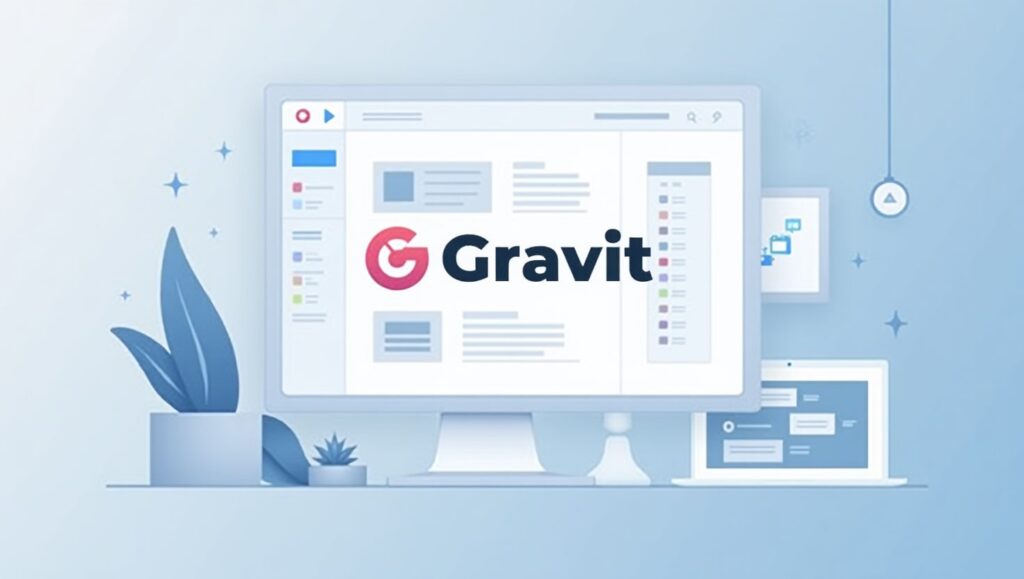
Type: Free & Paid (Gravit Designer Pro)
Platform: Web, Windows, macOS, Linux, Chrome OS
Gravit Designer offers a clean interface with essential tools for vector design. It’s ideal for creating UI designs, presentations, and illustrations, all from your browser.
Key Features:
- Works online and offline
- Modern user interface
- Cloud syncing
- Easy export options
Why it’s great for beginners: The learning curve is gentle, and it doesn’t require a powerful computer to run.
5. Vector – Free Vector Tool
Type: Free
Platform: Web, Windows, macOS, Linux
Vector is a completely free vector graphic design tool with a simple interface. It’s great for basic logos, icons, and infographics.
Key Features:
- Real-time sharing
- Simple and clean interface
- Free tutorials available
- Lightweight and fast
Why it’s great for beginners: Best graphic design tools for beginners without getting overwhelmed by advanced features.
6. Inkscape – Open Source Alternative
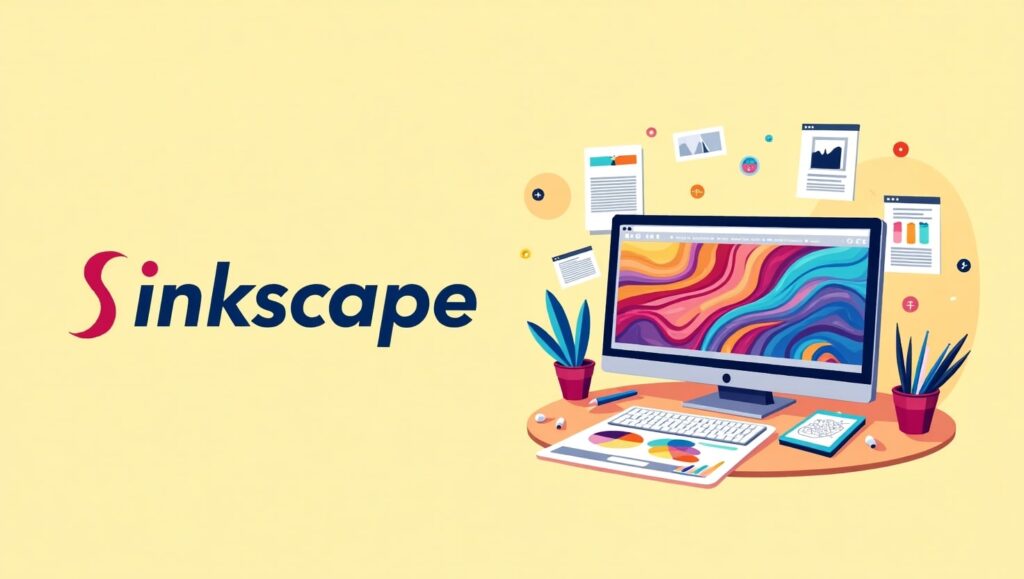
Type: Free (Open source)
Platform: Windows, macOS, Linux
Inkscape is a powerful free vector graphics editor that’s often compared to Adobe Illustrator. As an open-source tool, it has a strong community and regular updates.
Key Features:
- Advanced drawing tools
- Layer support
- File compatibility (SVG, AI, PDF)
- Custom extensions and add-ons
Why it’s great for beginners: Great for those who want full control over their design tools without paying for software.
7. Affinity Designer – Professional Quality at One-Time Cost
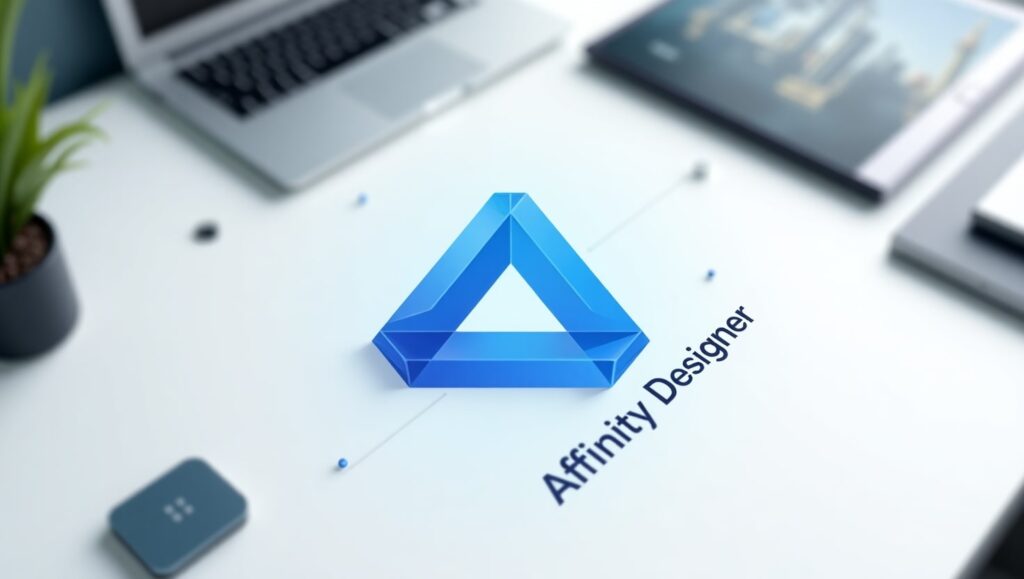
Type: Paid (One-time purchase)
Platform: Windows, macOS, iPad
Affinity Designer is a cost-effective alternative to Adobe Illustrator, offering professional features at a one-time price.
Key Features:
- Smooth vector and raster integration
- Responsive and lightweight
- Grid, snapping, and alignment tools
- Cross-platform performance
Why it’s great for beginners: Once purchased, you get lifetime updates. It’s a great investment without a subscription.
8. Pixlr – Easy Photo Editing
Type: Free & Paid
Platform: Web, iOS, Android
Pixlr is a lightweight photo editing tool that runs right in your browser. It’s perfect for beginners who want to edit images quickly for social media or blogs.
Key Features:
- AI-powered one-click edits
- Web-based—no downloads required
- Supports layers and effects
- Simple interface
Why it’s great for beginners: You can start editing without creating an account. Very beginner-friendly.
9. Krita – Digital Painting & Illustration
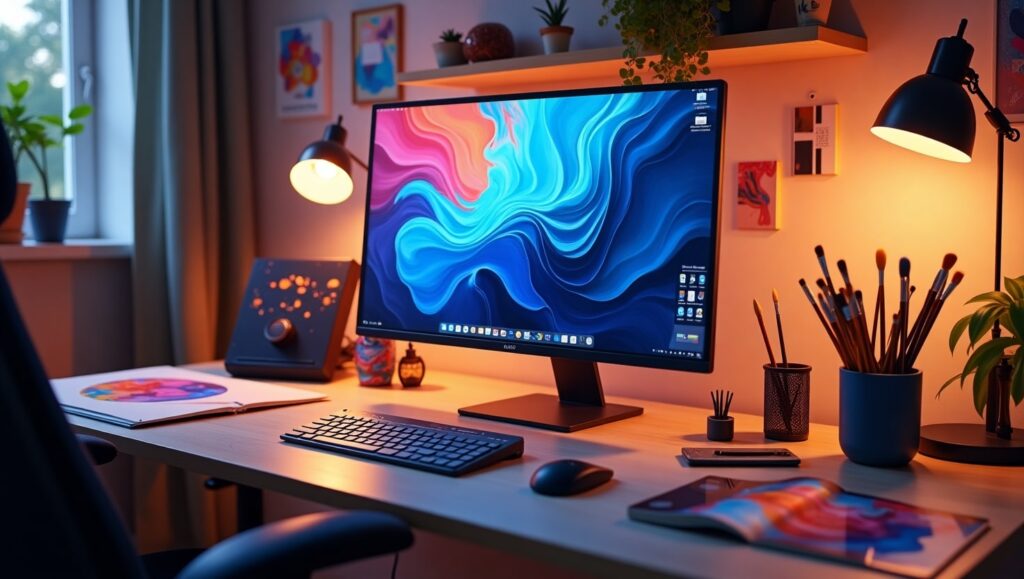
Type: Free (Open source)
Platform: Windows, macOS, Linux
Krita is best suited for digital illustration and painting, but it also offers graphic design tools for layout and composition.
Key Features:
- Brush customization
- Layer management
- Animation support
- Tablet-friendly interface
Why it’s great for beginners: Excellent for beginners interested in drawing and concept art.
10. Desygner – Mobile-Friendly Graphic Design
Type: Free & Paid
Platform: Web, iOS, Android
Desygner is a drag-and-drop graphic tool aimed at social media creators, bloggers, and marketers. It’s one of the easiest tools to use on a smartphone.
Key Features:
- Pre-made social media templates
- Mobile-first design
- Royalty-free image library
- Branding kit support
Why it’s great for beginners: If you’re creating graphics on the go, this is a must-have.
Tips on Choosing the Right Tool
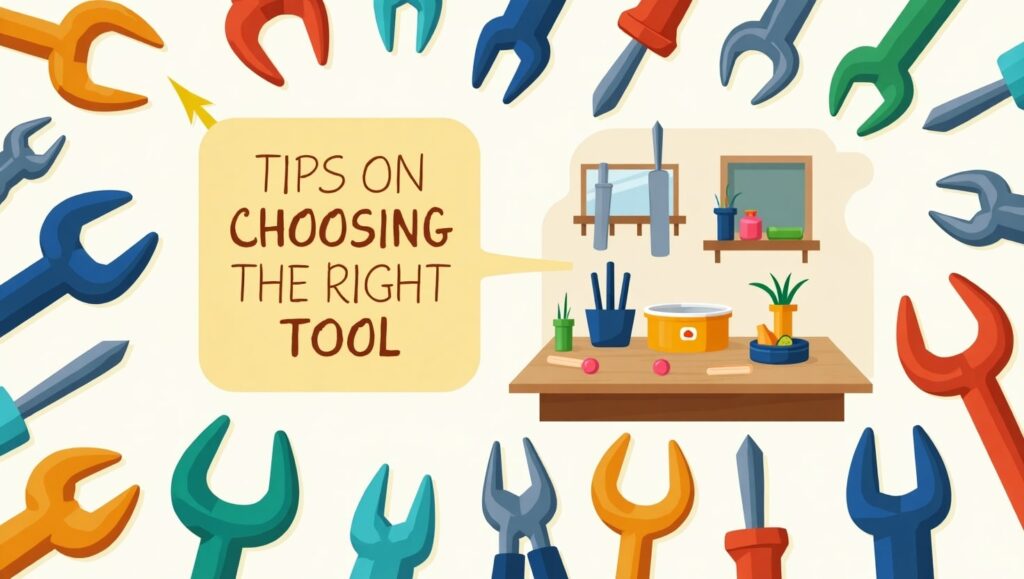
Choosing the best graphic design tools for beginners tool depends on your goals and workflow. Here are a few tips to guide your decision:
- Start Free: Explore tools like Canva, Vectr, and Inkscape to learn the basics without investment.
- Consider Your Goals: If you want to go professional, tools like Adobe Illustrator or Affinity Designer are worth learning.
- Try Before You Buy: Use free trials to test paid tools before committing.
- Use Community Resources: Many tools have active communities, free tutorials, and forums to help you learn faster.
- Match Tool to Task: Photo editing? Use Pixlr. UI design? Try Figma. Logo creation? Go with Illustrator or Vectr.
FAQ
What is the best free graphic design tool?
Canva is the best graphic design tools for beginners widely considered the best graphic design tools for beginners due to its ease of use, professional templates, and accessibility on all devices. For vector design, Inkscape is a top free choice.
Are paid tools worth it for beginners?
Yes, Best graphic design tools for beginners if you’re committed to building a career or serious hobby in graphic design. Tools like Adobe Illustrator and Affinity Designer offer features you’ll eventually need as your skills grow. However, you should explore free tools first to see what suits your style.
Conclusion: Start Simple, Grow Gradually
Every graphic designer starts somewhere. The key is to start simple—best graphic design tools for beginners, explore its features, and grow your skills at your own pace. Whether you begin with Canva, dive into Figma, or experiment with Inkscape, the most important thing is to keep creating.
Once you’re comfortable, consider investing in professional tools that open up even more creative possibilities. With the right tools and consistent practice, you’ll be creating stunning graphics in no time.
Graphics Design
Top 7 Essential Ways to Make T-Shirt Painting Design
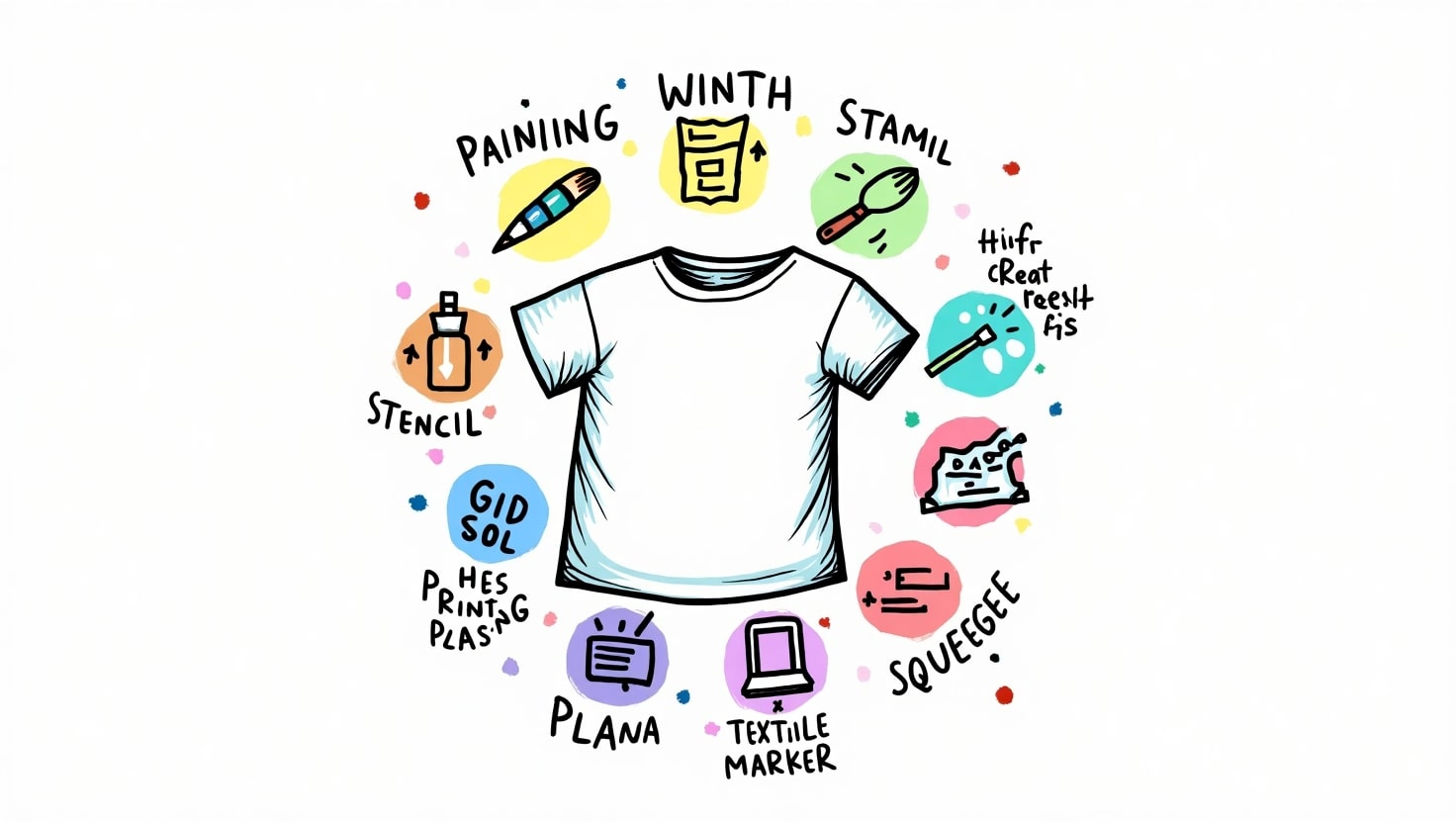
Top 7 Essential Ways to Make T-Shirt Painting Design
T-Shirt Painting Design can be a great tool of creativity or creation of a fashion identity or even a business. T-Shirt Painting can be a gateway to unending crafts no matter whether this would be your first or fourth attempt in painting. In this article, we are going to guide you on the 7 best methods on how to make t-shirt painting design stand out, how to do it, what to use, what style, and some tips on how to make custom t-shirt painting better without fail.
What is T-shirt Painting Design?
T-Shirt Painting Design is a decoration process of painting or ink on a piece of cloth, generally t-shirt, to come up with a unique picture. It is a form of clothing art in which an artist, fashion admirer or hobbyist can express themselves creatively in something that they can use daily. T-shirt painting design can express mood, culture, personality and even be used to champion a cause; miniature paintings to splashes of abstract colors.
DIY trend, sustainability and fashion individuality have rocketed the popularity of the t-shirt painting within the past years. Well, now we are to see the seven most useful techniques that can help you to master this exciting art.
1. Select The Appropriate T Shirt Base and Fabric
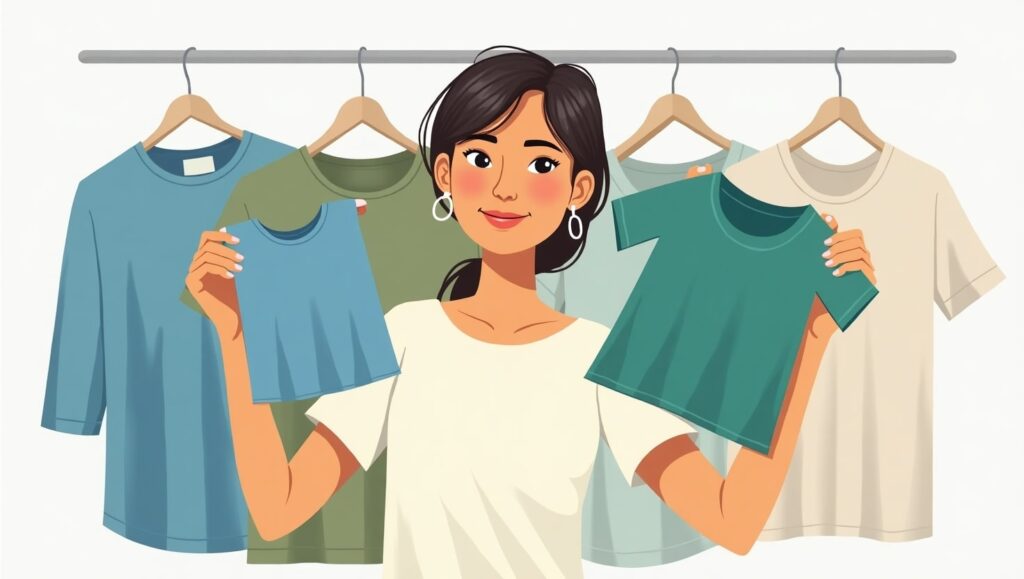
A t-Shirt Painting Design is the basis of every magnificent t-Shirt Painting. The choice of the material influences the quality of the adhesion of the paint, the hues of the palette and the durability of the design once washed.
The ideal fabrics of T-Shirt painting design:
- 100 percent Cotton: Trapping moisture is high on the scale and paint adhesion can also be achieved as well.
- Cotton-Poly Blend: Less absorbent and more long lasting.
- Bamboo or Organic cotton: an environmental-friendly and sustainable t-shirt painting design material.
Ensure that the t-shirt has already undergone a process of washing in order to draw away any factory treatment or shrinking. Get the finest painting experience on a smooth, non wrinkly surface.
2. Gather the Right Supplies
Without proper tools, even the most creative ideas for a t-shirt painting design can fail. Here’s a checklist of essential supplies:
Basic Materials:
- Fabric Paint (Acrylic-based or Water-based)
- Fabric Medium (optional, helps paint bond better)
- Paintbrushes of varying sizes
- Sponges or Rollers
- Palette or Mixing Tray
- Fabric Markers
- Pencil/Chalk (for sketching)
- Cardboard Insert (to avoid bleed-through)
These materials ensure your t-shirt painting design stays sharp, professional, and vibrant.
3. Sketch and Plan Your Design
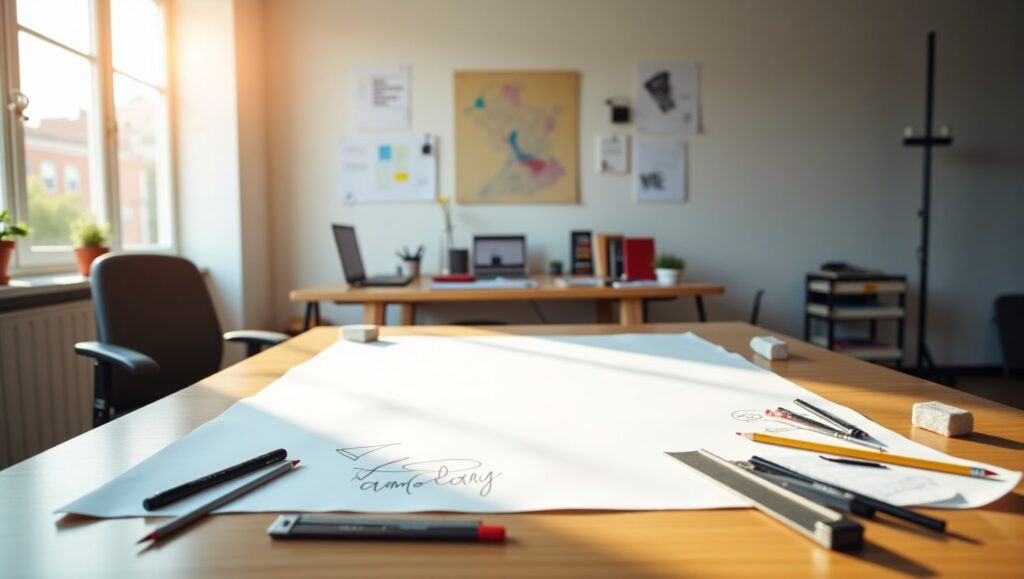
Before you dip a brush into paint, sketch your t-shirt painting design on paper or use a digital mockup tool. Planning is critical, especially for intricate designs.
Tips for Sketching:
- Start with light outlines.
- Consider color placement and negative space.
- Use stencils if you’re aiming for precision.
Planning your t-shirt painting design reduces mistakes and speeds up the painting process. You can even use transfer paper to trace your design onto the fabric if you’re not confident in freehand sketching.
4. Learn Different Painting Techniques
There are multiple ways to apply paint to a t-Shirt Painting Design. Understanding the right technique for your t-shirt painting design will make your artwork more dynamic.
Popular Painting Techniques:
- Freehand Brush Painting:
- Great for artistic expression and detailed artwork.
- Stencil Painting:
- Perfect for logos, patterns, or text. Ensures consistency.
- Sponge Painting:
- Adds texture and gradient effects to your t-shirt painting design.
- Splatter Technique:
- Offers a trendy, modern vibe. Use with contrasting colors.
- Block Printing:
- Involves carving a design into a stamp and repeating the pattern.
Each technique contributes something unique to the final look of your t-shirt painting design. Don’t hesitate to mix methods for a layered effect.
5. Learn to Use colors
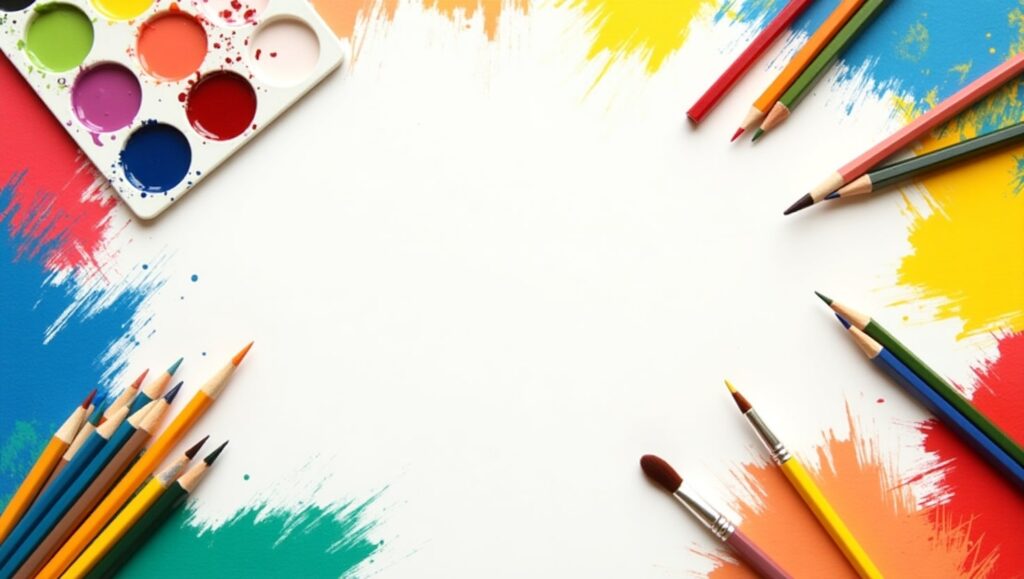
The color theory is very relevant in the area of painting t-shirts. Navigating a basic design with the compulsory color palette can turn a design to a work of art.
Know How to Select Colour:
- Take bold contrast by using complementary colors.
- Similar tints to bring out harmonious vibes.
- Apply white or black to make outlines/highlights.
Bear in mind that not all colors can be similar on textile and paper. Always test a small patch in case you want complete painting of t-shirt.
6. Use Fixing and Heat Fixing Methods
When you have painted your masterpiece that is the time to put the colors on so that they can be washed and worn.
T-Shirt Painting Design: Fixing Methods:
- Ironing: Apply a cloth or parchment paper on the painted area and press using medium heat setting on the iron within 3 to 5 minutes.
- Air-Drying: Leave your t-shirt painting design to dry up at least 24-48 hours.
- Heat Press: professional way of commercial-grade finish.
The paint is then sealed under the heat setting so it does not crack or fade, thus sealing into the fibers of your t-shirt painting design.
7. Care of Your Painted T Shirts
When the t-shirt painting is properly taken care of, then you get a long lasting life of the design and it remains vibrant.
Cleaning & Storing Information:
- Inside out wash in cold water.
- Never use bleach or strong detergents.
- Line dry or tumble low or machine dry.
- Iron inside-out, as required.
Once you have made something really well, you can be sure that your t-shirt painting design will keep shining all through the years.
Some Creative Ideas to Design T-Shirt Painting
Are you short of ideas? The popular t-shirt painting design themes are the following:
Minimalist Quotes
- Nature-based Patterns
- Graffiti and Street Style Painting
- The pop culture and Anime
- Geometric designs
- Motifs Tribal and Ethnic Motifs
- Personalized Name/Initials
The ideas can assist you to stimulate creativity and reach out to the target audience or customers.
The reason T-Shirt Painting Design is ideal with small businesses
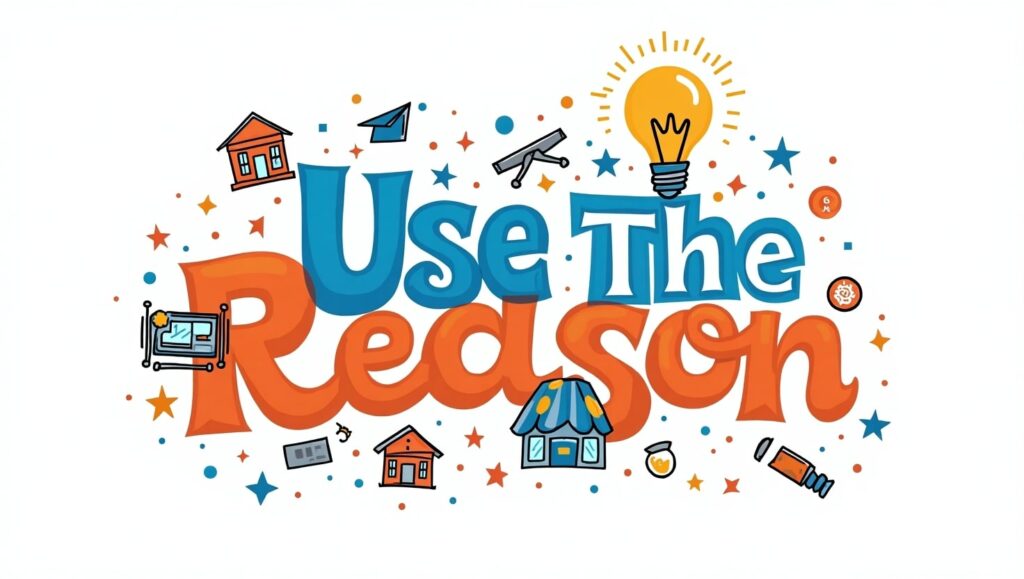
T-shirt painting design is also beautiful since the cost is cheap with high profit margin. These designers, painters, and designers are turning the ability to make money by selling personalized tees either online or in local fairs.
The advantages of T-Shirt painting Design as Business:
- No huge stock-out is needed.
- It is possible to tailor every design to the targeted niches.
- Handmade and green-friendly.
You may even provide customized t-shirt painting design services to such platforms as Etsy, Instagram, or your WordPress online store.
Questions and answers on T-shirt painting design
Q1. What should I use as a medium to paint t-shirt painting design, can I use normal acrylic paint?
Sure but in some fabric medium so that it does not crack and leave a soft finish.
Q2. How do I avoid loosing the paint in the washing?
After getting your paint design on your t-shirt completely dry, always take it and heat set it using an iron or heat press.
Q3. Which is the best color of t-shirt to be used?
T-shirts that are white and light in color are ideal for colored effects, but another to get dramatic effects is to use black t-shirts and use opaque or metallic paints.
Q4. What is the lifespan of painted t-shirt?
Well improvised t-shirt painting design will take a long time even after a lot of washings before it will begin to fade away.
Q5. Are children allowed to do t-shirt painting designs?
Absolutely! Just use paint that is washable and non toxic and monitor them as they set the heat.
Conclusion
The t-shirt painting design can be mastered by all types of artists, hobbyists, and business people. Selecting the appropriate fabric, preparing the design, printing it on, and employing the final heat fix, there are tips and methods to every process, which makes the result a beautiful and lasting t-shirt painting design. These 7 methods will determine what colorful and professional results you would achieve when creating a one-off work of your own or planning to launch a fashion brand.
The more you practice regularly and creatively, the more you will master t-shirt painting designs, and welcoming the world of art and even money.
Graphics Design
Essential Graphic Design Skill List for Freelancers
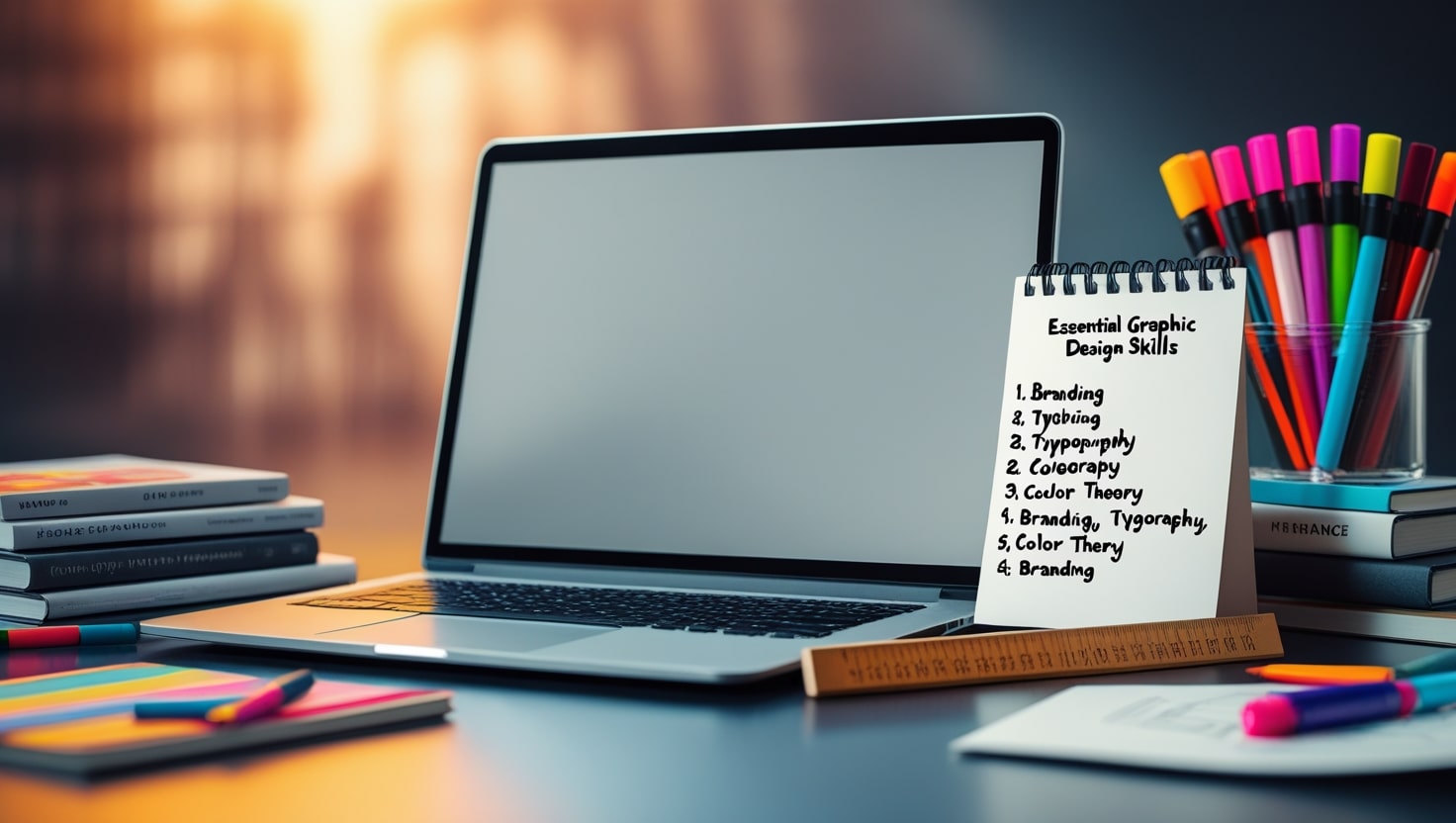
Essential Graphic Design Skill List for Freelancers
Graphic design skill list nowadays, it does not suffice to be a talented freelance designer in the way of the fast-moving creative economy. It demands balanced skill set of graphic designs that entails technical and soft skills. As a beginner or someone seeking to advance their career, being great in the basic graphic design skill list can also pave the way to greater clients, more money, and ultimate success in the relationship.
We will discuss all the skills you have to cover in your graphic design skill set, starting with basic tools and culminating in the skills required by a professional graphic designer. We will also discuss why these skills are important and how to master them as well as how to utilize them to get the right clients and projects depending on your expectations.
1. Graphic Design Skill List Introduction The Graphic Design Skill List is an important attribute of a Graphic Designer.
The graphic design skill list abilities that you have is your toolkit as a freelancer. It comprises all the knowledge about software along with thoughtful planning, interaction and communication with clients, and developing the identity of a brand. The fact that having a structured graphic design skill list list will not only enable you to analyze your capabilities as well as shortcomings, but also offer you easy time to sell your services.
The majority of businesses are heading towards freelance professionals to serve them with creative problems such that a present and relevant list of graphic design skill list will make sure that you stay ahead of others in this highly competitive industry.
2. The issue of acquiring a skill set among freelancers.

In contrast to agency designers, freelancers do not get the luxury of riding on a team. You are the designer, the project owner, the marketer and the communicator. Thus, it is vital to develop a rich and robust skill set of a graphic designer to your independence and development.
Having a comprehensive list of graphic design skill list also creates self-confidence among the clients. It demonstrates that you can also work with an impressive range of assignments: both coming up with graphic design skill list to place on social media and creating a whole brand identity.
3. The Basic Skills required by Every Freelancer in Designing
You should not run with sophisticated tools or some specific designs that you might be familiar with at an early stage. The basic list of the graphic design skill list comprises:
- Design principle (contrast, balance, alignment, repetition)
- Design of composition and layouts
- Visual hierarchy
- Simple form drawing or wire framing
- Thinking and problem solving design
These are fundamental aspects that these skills in professional graphic designing revolve around. In their absence, your visuals might not be coherent or even effective, regardless of their apparent visual attractiveness.
4. High-end Graphic Designing Techniques
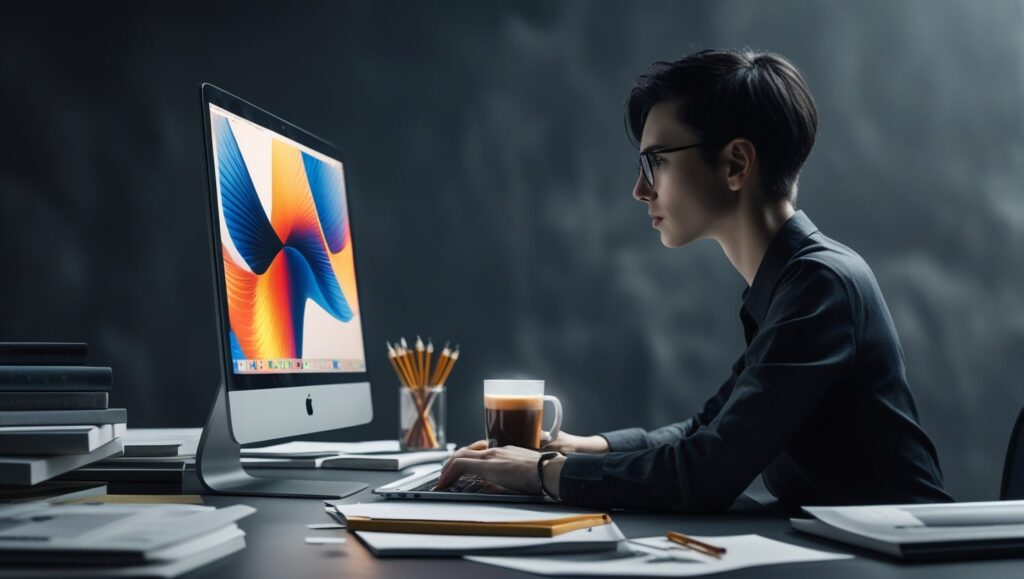
When you already managed to master the basics, it is high time to enter some more sophisticated elements of your graphic design skill list set:
- Photo manipulation and editing
- Vector drawing
- Icons design
- Infographic design
- The fine use of layering and masking
Such advanced skills will enable you to take on more involved projects such as packaging design, editorial layouts, or a digital campaign that will increase your worth as a freelancer.
5. The Accommodation Skill list of Graphic Design Software Proficiency

Your knowledge of some major design software is one of the most important elements of your graphic design skills list. As a freelancer you have to feel comfortable with the best tools of the industry:
- Adobe Photoshop: Digital painting and photo editing
- Adobe illustrator: Vector graphic and logo design
- Adobe InDesign: documents/publications with three or more pages e.g. brochures, eBooks
- Figma/Sketch/XD: UI/UX and Web Graphic Design
- Canva: Rapid template-based design Canva can be used to create beautiful templates in very little time.
The more tools you will be able to learn and to expand the list of tools on your set of skills of graphic design skill list the more you become versatile and employable.
6. Skills in Type and Design
Typography is also what it takes to make or break a design. When you combine this knowledge to your graphic design skill list set, then you comprehend:
- Pairing and contrast of fonts
- Space and legibility
- Typographical hierarchical use
- Balance in grids and layouts
This is why freelancers who are experts in typography are mostly recruited when encountered with branding, editorial, and advertising work where text is as equally important as imagery content.
7. Theory and practice in Color
The good design is very dependent on a proper color application. Ensure your skill set in graphic designing has:
- The knowledge of the color modes (RGB vs CMYK)
- Psychology of colors
- the palette making
- Harmony and contrast of color
Clients will usually wish to have their brand colors to elicit certain emotions and practicing color theory will help you add value to your company as a freelancer.
8. Branding and Image Design
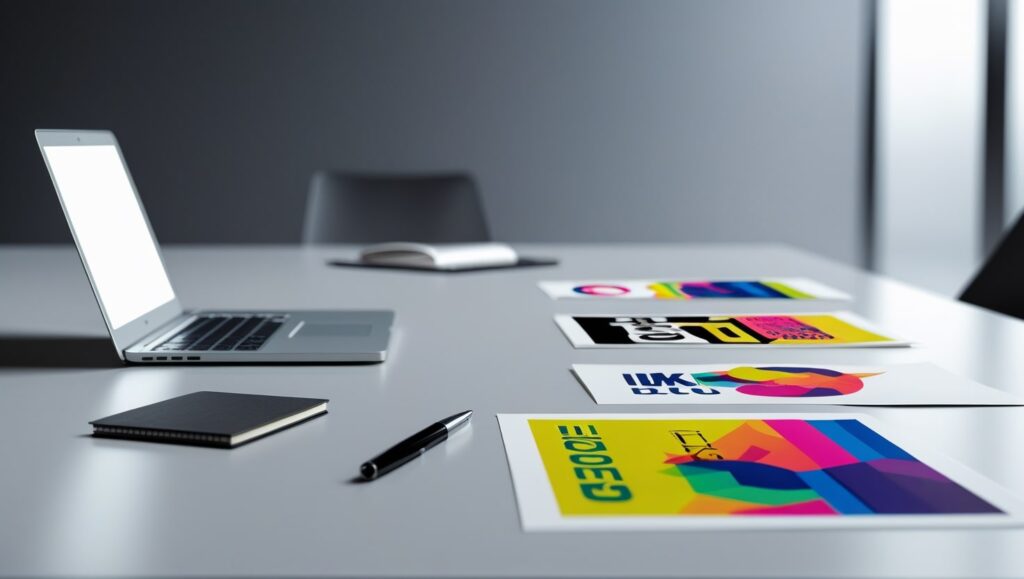
Branding expertise can help a freelancer earn good money on huge projects. To your list of graphic design skill list add the following:
- Logo designing
- Brand strategy and mood boards
- Brand guidelines
- Graphical narrations
Branding identities go beyond creation of logos but include deciphering how a company should communicate in terms of graphics; it is on the platform.
9. UX/UI Designing Skills as a Freelancer
Freelancers capable of providing UX/UI services are usually paid higher. Completing the list of your graphic design skill list with UX/UI means:
- Drawing wireframes and prototypes
- User journey mapping
- Designing mobile-first
- UI Design of the app/ Web
Such competencies are quite desirable with companies focusing more on digital user experience.
10. Motion Graphics and Animation
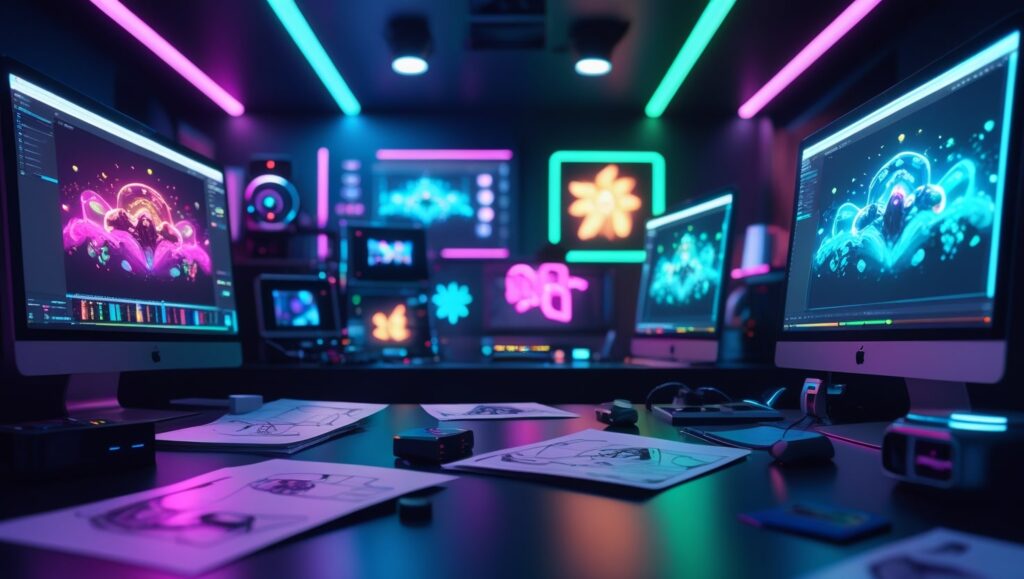
The digital space is taken over by motion. Motion design is something that sets you apart in the list of graphic design skill list. Get to know such tools as:
- Animations will be in After Effects
- Lottie on the web-based animations
- GIF making and video hacks
Even simple motion skills make a still stand, it allows creating a dynamic experience, ideal to share on social media and advertisements.
11. Collaboration and Communication skills
Soft skills are good elements of a graphic design skill list as well. You will have to be able to:
- An excellent skill at explaining things
- Know the needs of clients
- Treat feedback in a professional manner
- Liaise with other artists or marketers
Effective communication leads to the flow of work, improved success of projects and repeat clients.
12. Time and Project Management
Freelancers have to work on different projects. Time management should, therefore, find its place on the list of your graphic design skill list:
- Working with such an application as Trello, Notion, or Asana
- Maintaining due date and revisions
- Invoicing and ability to follow up clients
These are some of the productivity habits that enable you to be professional and you achieve expectations.
13. Marketing Freelance Designer
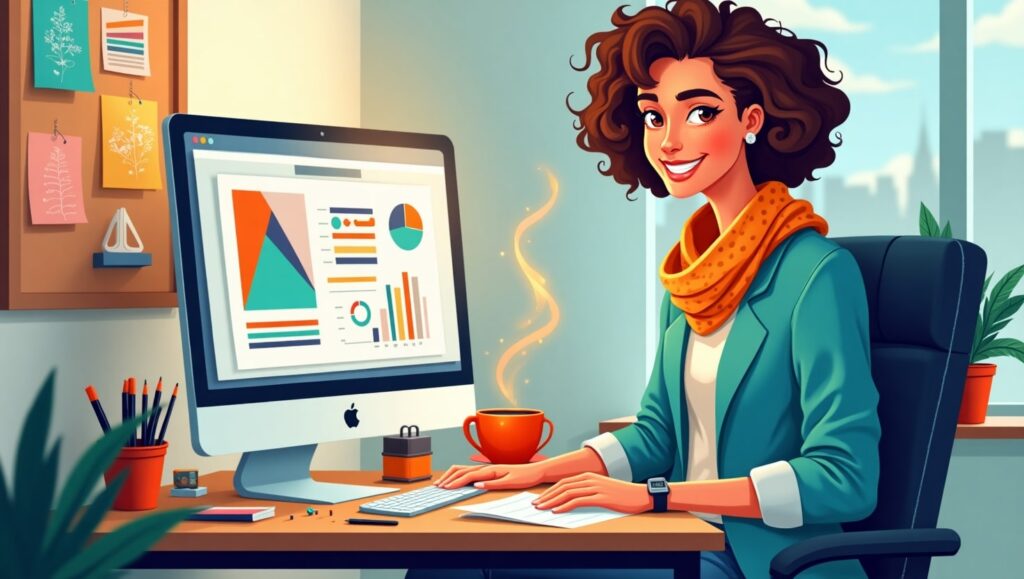
Self marketing is one thing that you never had to write on your list of graphic design skill list, but what you really need to do:
- Creation of a portfolio site
- Sharing work via social media
- Authorship of blogs or case studies
- Social networking on the web
The greatest designers cannot cope, when they are not visible. Marketing converts your talents into money making.
14. Your Application of Graphic Designs List in the Real World
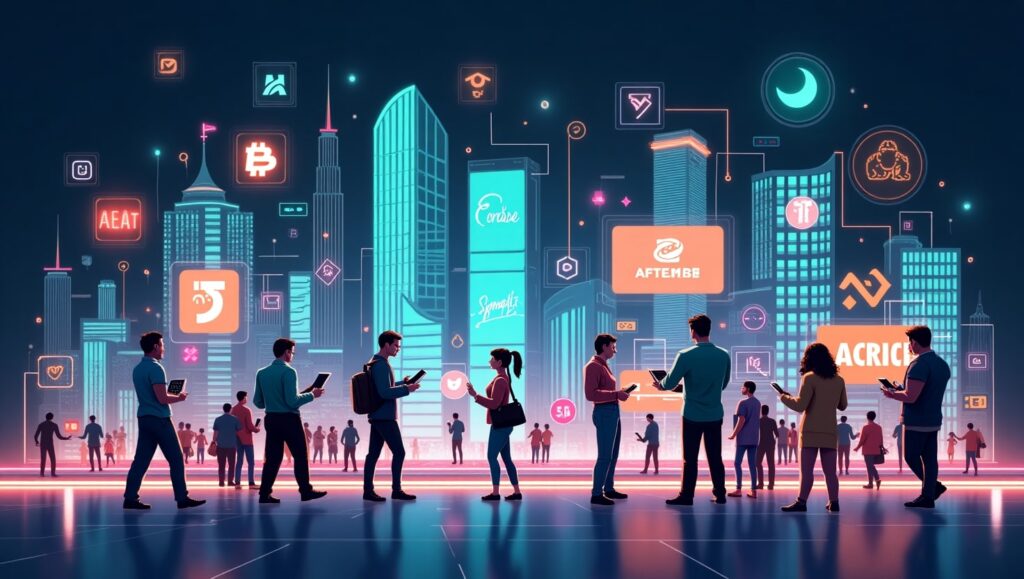
Your graphic design skill list should match the demand in the market. Put your abilities to:
Branding and logo assignments
- Designing of websites
- Digital advertising resources (ads, banners, email)
- Printed resources (flyers, business card)
- e-commerce Designs of products
A variety in the application of your graphic design skill list also enhances your reputation and gets a variety of clients.
15. What are the Ways of Developing Your Skill Set Continuously?
The artistic world is evolving rapidly. Make sure your graphic design skill list is not obsolete by:
- Doing online courses (Skillshare, Coursera, YouTube)
- Research of design fashion
- Doing it every day
- Asking another peer or even a mentor
The best freelancers are those who never stopped learning. Each new skill that you develop can translate to work that is of higher value.
16. FAQs
Q1. What must be in freelance graphic design skill list?
The freelance graphic design skill list must enroll software expertise, design philosophy, branding, constructing, user interface/user experience, commitment management, and organizational communicational proficiency.
Q2. What can I do to add to my list of skills in graphic design?
Continuously expand your list of graphic design skills by taking online courses, working on real-life projects, keeping up with design trends, and learning more through feedback by your mentors.
Q3. What is the importance of a graphic design skill list to freelancers?
It will make you competitive, versatile, and allow you to gain trust by potential clients because it will be evident what you are able to provide.
Q4. Is it possible to freelance when my graphic design list of skills is not very long?
Yes, but it will be limited by what you can do. Begin with the basic skills and slowly increase your freelance career with some extended skills list in graphic design.
Q5. Which skill is the most needed in a list of graphic designs skills today?
The same goes with UX/UI design, motion graphics, and branding opportunities that are highly sought as freelance assignments.
17. Final Thoughts
This is the most valuable resource a freelancer can have a checklist of graphic design skills. Not only will it make your work better, but it increases your confidence and credibility as well. With the combination of technical and soft skills you will become a trustful and multi-tasking designer that clients would not mind hiring again.
You are about to have a fresh start or a long time established and it is your time to look back, improve, and add some new things to your list of graphics design skills. It is a fact that success lies in the hands of those who are well equipped- so develop your talents, present them in a way they are attractive, and keep stretching your creative boundaries.
-
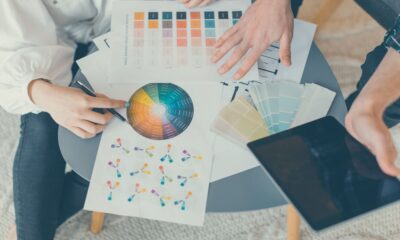
 Graphics Design1 year ago
Graphics Design1 year ago7.Exploring the Importance of Color Theory Charts
-
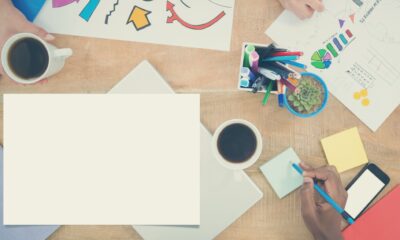
 Graphics Design1 year ago
Graphics Design1 year ago15.The Importance of Effective Flyer Design in Marketing
-
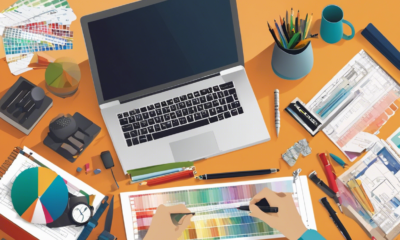
 Graphics Design1 year ago
Graphics Design1 year ago14.Mastering the Art of Print Design: Tips and Tricks
-
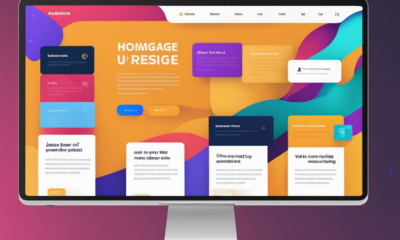
 Graphics Design1 year ago
Graphics Design1 year ago10.The Latest Trends in Web Design and Development
-

 Graphics Design1 year ago
Graphics Design1 year ago29.Retro Design Is Making a Comeback in Modern Spaces
-
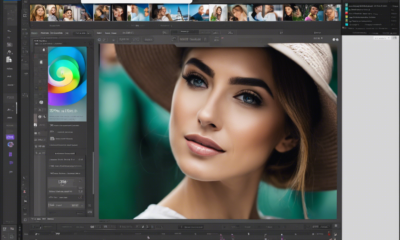
 Graphics Design1 year ago
Graphics Design1 year ago13.Exploring the Latest Trends in Photo Editing Software
-
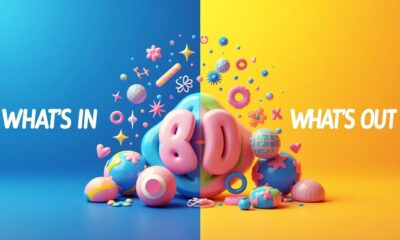
 Graphics Design5 months ago
Graphics Design5 months ago2025 Logo Design Trends: What’s In, What’s Out?
-
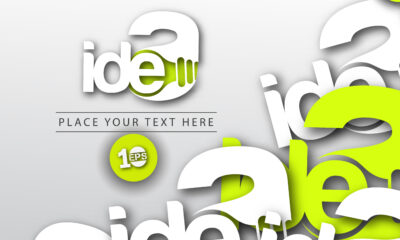
 Graphics Design1 year ago
Graphics Design1 year ago1.The Transforming Power of Typography on Graphic Design






Free Temporary Email
September 25, 2024 at 7:40 am
Awesome! Its genuinely remarkable post, I have got much clear idea regarding from this post
disposable Temporary Email
September 28, 2024 at 7:39 am
naturally like your web site however you need to take a look at the spelling on several of your posts. A number of them are rife with spelling problems and I find it very bothersome to tell the truth on the other hand I will surely come again again.
Tech Learner
October 25, 2024 at 3:00 pm
Tech Learner Great information shared.. really enjoyed reading this post thank you author for sharing this post .. appreciated
Cortez Jerald
October 26, 2024 at 6:52 am
Howdy! I know this is kinda off topic but I was wondering which blog platform are you using for this site? I’m getting tired of WordPress because I’ve had issues with hackers and I’m looking at alternatives for another platform. I would be great if you could point me in the direction of a good platform.
Building reinforcement carbon plates
November 4, 2024 at 8:47 am
You have brought up a very good points, regards for the post.
Maximo Liquori
November 15, 2024 at 4:17 am
Your style is so unique compared to many other people. Thank you for publishing when you have the opportunity,Guess I will just make this bookmarked.2